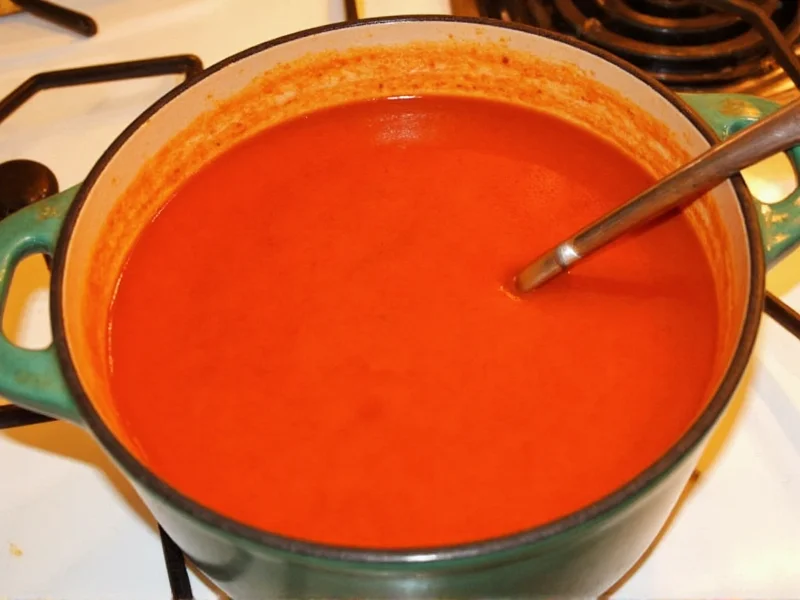Creating exceptional tomato soup doesn't require culinary school training—just quality ingredients and proper technique. This versatile recipe delivers rich flavor whether you're using summer-ripened garden tomatoes or quality canned varieties during off-season. The secret to restaurant-quality tomato soup at home lies in balancing acidity, building flavor layers, and achieving perfect texture without relying on heavy cream.
Essential Ingredients for Perfect Tomato Soup
Quality ingredients form the foundation of exceptional tomato soup. While supermarket tomatoes work year-round, heirloom varieties shine in summer. Here's what you'll need for an 8-serving batch:
| Ingredient | Quantity | Substitution Options |
|---|---|---|
| Ripe tomatoes or quality canned | 2 lbs fresh or 2 (28-oz) cans | San Marzano tomatoes preferred |
| Yellow onion | 1 medium, diced | Shallots for milder flavor |
| Garlic cloves | 2-3, minced | 1 tsp garlic powder in pinch |
| Vegetable broth | 2 cups | Chicken broth or water |
| Olive oil | 2 tbsp | Butter or avocado oil |
| Fresh basil | 1/4 cup chopped | 1 tsp dried basil |
| Baking soda | 1/8 tsp | Neutralizes tomato acidity |
Equipment Checklist
You don't need specialized equipment for this easy homemade tomato soup recipe. Essential tools include:
- Large heavy-bottomed pot (prevents scorching)
- Immersion blender or regular blender
- Wooden spoon for stirring
- Sharp chef's knife and cutting board
- Measuring cups and spoons
Step-by-Step Cooking Instructions
Follow these precise steps for the best tomato soup recipe for beginners that delivers complex flavor with minimal effort:
- Sauté aromatics: Heat olive oil over medium heat. Add onions and cook until translucent (5-7 minutes). Add garlic and cook 1 minute until fragrant.
- Add tomatoes: Pour in tomatoes with their juices. For fresh tomatoes, add 1/4 cup water to prevent sticking.
- Build flavor: Stir in broth, basil, 1 tsp salt, and 1/4 tsp black pepper. Add baking soda to neutralize acidity.
- Simmer gently: Bring to simmer then reduce heat to low. Cover and cook 25 minutes, stirring occasionally.
- Blend smoothly: Remove from heat. Use immersion blender directly in pot until completely smooth (2 minutes).
- Adjust consistency: Add additional broth if too thick, or simmer uncovered 5 minutes if too thin.
- Final seasoning: Taste and adjust salt, pepper, or add 1 tsp sugar if tomatoes are overly acidic.
Avoiding Common Tomato Soup Mistakes
Even experienced cooks make these errors when preparing creamy tomato soup without cream:
- Skipping the sauté step: Raw onions create harsh flavor. Properly cooked aromatics build flavor foundation.
- Over-blending hot soup: Always cool slightly before blending to prevent pressure explosions.
- Using poor quality canned tomatoes: Choose San Marzano DOP certified for authentic flavor.
- Adding dairy too early: If using cream, stir in during final minute of cooking to prevent curdling.
- Under-seasoning: Tomatoes require more salt than expected—season in increments while tasting.
Serving Suggestions and Pairings
Elevate your healthy tomato soup recipe with these professional presentation tips:
- Drizzle with basil oil (blend 1/4 cup olive oil with 2 tbsp fresh basil)
- Add texture with homemade croutons or pumpkin seeds
- Pair with grilled cheese sandwiches using sharp cheddar
- Serve with a side salad of arugula and shaved Parmesan
- Garnish with fresh basil leaves just before serving
Storage and Reheating Instructions
This quick tomato soup recipe stores exceptionally well:
- Refrigeration: Cool completely and store in airtight container for up to 5 days
- Freezing: Portion into freezer bags (lay flat) for up to 6 months
- Reheating: Warm gently over medium-low heat, stirring frequently
- Reviving: Add 1-2 tbsp broth when reheating to restore perfect consistency
Delicious Recipe Variations
Customize this classic tomato soup cooking instructions for different dietary needs and preferences:
Vegan Creamy Version
Add 1/4 cup raw cashews (soaked 2 hours) before blending for rich creaminess without dairy. Alternatively, use 1/3 cup full-fat coconut milk stirred in at the end.
Roasted Garlic Tomato Soup
Roast 1 whole garlic head (top sliced off, drizzled with oil, wrapped in foil) at 400°F for 30 minutes. Squeeze softened cloves into soup during blending for deep, sweet garlic flavor.
Spicy Arrabbiata Style
Add 1/2 tsp red pepper flakes with aromatics and 1 tbsp balsamic vinegar during simmering for an Italian-inspired spicy tomato soup.
Quick Weeknight Version
Use 2 (28-oz) cans fire-roasted tomatoes, 1 tbsp tomato paste sautéed with onions, and 2 cups broth for a 25-minute tomato soup recipe with fresh tomatoes alternative.











 浙公网安备
33010002000092号
浙公网安备
33010002000092号 浙B2-20120091-4
浙B2-20120091-4